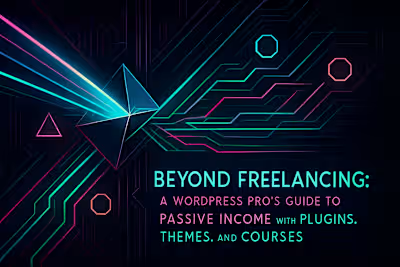Don't Just Build Websites: How to Double Your Project Value with Smart Upselling for WordPress Freelancers

Don't Just Build Websites: How to Double Your Project Value with Smart Upselling for WordPress Freelancers
The Mindset Shift: From One-Off Projects to Long-Term Partnerships
Identifying Upsell Opportunities Before, During, and After the Project
The Discovery Phase: Planting the Seeds for Future Work
During Development: Suggesting Smart Add-ons
The Post-Launch Handoff: The Perfect Time to Pitch Ongoing Services
The Most Profitable Services to Upsell and Cross-Sell for WordPress Freelancers
Recurring Revenue Gold: Website Care and Maintenance Plans
'Will My Site Be Fast?': Selling Performance Optimization Packages
'Will I Show Up on Google?': Offering Foundational SEO Services
Content and Email Marketing Support
Advanced Functionality: E-commerce, LMS, and Custom Plugin Development
How to Pitch Your Additional Services Without Being Pushy
Framing it as a Solution to Their Problems
Creating Service Packages and Tiers
References
Don't Just Build Websites: How to Double Your Project Value with Smart Upselling for WordPress Freelancers
The Mindset Shift: From One-Off Projects to Long-Term Partnerships
Identifying Upsell Opportunities Before, During, and After the Project
The Discovery Phase: Planting the Seeds for Future Work
During Development: Suggesting Smart Add-ons
The Post-Launch Handoff: The Perfect Time to Pitch Ongoing Services
The Most Profitable Services to Upsell and Cross-Sell for WordPress Freelancers
Recurring Revenue Gold: Website Care and Maintenance Plans
'Will My Site Be Fast?': Selling Performance Optimization Packages
'Will I Show Up on Google?': Offering Foundational SEO Services
Content and Email Marketing Support
Advanced Functionality: E-commerce, LMS, and Custom Plugin Development
How to Pitch Your Additional Services Without Being Pushy
Framing it as a Solution to Their Problems
Creating Service Packages and Tiers
References
Posted Jul 6, 2025
Maximize your revenue from every client. Learn the art of upselling and cross-selling services like maintenance, SEO, and performance optimization to significantly increase your income as a WordPress freelancer.








![How to Rank #1 for "WordPress Developer in [Your City]": A Local SEO Guide](https://media.contra.com/image/upload/w_400,q_auto:good,c_fill/gpcdduboqfzsbxg7hnxz.avif)
